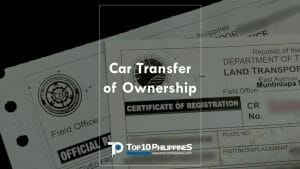Table of Contents
When selling second-hand or pre-owned cars, the process doesn’t just involve looking for a buyer and receiving the payment. There’s also what we call a transfer of ownership in the Philippines. This action is made to let the Land Transportation Office (LTO) be aware of the sale that took place and the change of ownership of the car.
Here in the Philippines, the seller is commonly the one who processes the transfer of car ownership. So, if you plan on selling your vehicle in the near future, you need to know the process of transfer of car ownership in the Philippines. Take the time to see the steps listed below.

How Does a Transfer of Car Ownership in the Philippines Work?
In the Philippines, the process of transferring car ownership is not as simple as signing a piece of paper. There are certain requirements that must be met in order for the transfer to be legal. The first step is to secure a notarized deed of sale from the previous owner. This document must state the date of purchase, the buyer’s name, and address, and the seller’s name and address.
In this transfer of car ownership in the Philippines guide, we will provide a step-by-step process.
Step 1: Prepare the requirements

Like any legal process, getting the requirements ready is also part of how to transfer car ownership Philippines.
Step 2: Go to the LTO branch with your car

Bring the car subject to the transfer of ownership to LTO. Keep in mind that you need to bring the vehicle to the LTO branch where it was initially registered. But if the original file of the car’s certificate of registration is available at the main LTO in East Ave, Quezon City, then you can perform the process at any LTO branch.
Additionally, make sure you have all the requirements for the transfer of ownership when you go to the LTO branch.
Step 3: Get your car inspected

The car will then undergo inspection by the LTO to check if everything on the document is correct. This step includes emissions testing. Of note, you might have to perform emissions testing at an LTO-certified Private Emission Testing Center.
Step 4: Submit the requirements

Line up at any counter and present all the necessary documents. The LTO staff will then calculate the cost you need to pay.
Step 5: Pay the fee

Proceed to the cashier and pay the fee. The amount is somewhere around Php 530 to Php 680.
Step 6: Wait for the new documents

After paying, all you have to do is wait for the new documents to be released, including a new CR, and stickers, among others. Do check the documents before you head home.
Photocopy the newly issued documents as many as you can and keep some for yourself for your reference. Typically, there are some photocopying machines near or in the office, and you can have them photocopied for a nominal fee.

Requirements: Transfer of Car Ownership in the Philippines
In order for the transfer of car ownership in the Philippines to proceed, the following requirements must be met:
1. The car must be registered with the Land Transportation Office (LTO).
2. The car owner must have a valid driver’s license and other government-issued IDs.
3. The car owner must submit the required documents to the LTO, which include the deed of sale, registration certificate, and proof of insurance.
4. The new owner must pay the applicable fees.
5. The new owner must have the car inspected at an LTO-accredited inspection center.
6. The new owner must register the car in his or her name at the LTO.
7. The new owner must apply for a new license plate number.
8. The owner must secure a new Certificate of Ownership from the LTO.
9. The new owner must pay the applicable taxes.
10. The car must be presented for inspection at an LTO-accredited inspection center within thirty days after the registration of ownership is completed.

Transfer of Car Ownership in the Philippines: What are the benefits?
When selling or gifting a car, it is important to complete a transfer of car ownership in the Philippines to ensure the new owner is protected. There are many benefits to transferring ownership, including protecting the new owner from liability and protecting yourself from future liability.
A transfer of ownership also provides peace of mind for both the buyer and the seller. The buyer knows that they are now the legal owner of the vehicle, and the seller knows that they are no longer responsible for what happens with the vehicle. This could be especially important if something were to happen to the vehicle after the sale, such as if it were involved in an accident or if it was stolen.
What happens if you don’t transfer ownership of a car?
When you purchase a car, the title is transferable to your name. Transfer of car ownership in the Philippines is important to do because it shows that you are the legal owner of the vehicle. If a Filipino car buyer does not transfer ownership of the car, then the buyer is not the legal owner, and the car could be repossessed.
In addition, if a Filipino driver is caught up in an accident and doesn’t have insurance, they could be sued for damages. So it’s important to make sure that a Filipino buyer is the legal owner of the car by transferring ownership into their name.

Tips: Helpful tips for transferring car ownership in the Philippines
When you buy a car in the Philippines, the process of transferring ownership is simple as long as you have all the necessary documents. Here are some helpful tips to make sure the process of transfer of car ownership in the Philippines goes smoothly:
1. Make sure you have the following documents: sales invoice, Certificate of Registration (CR), Official Receipt (OR), and Transfer Certificate of Title (TCT). The seller should be able to provide you with all of these.
2. Go to the Land Transportation Office (LTO) to have the transfer of ownership processed. You will need to fill out some forms and pay a fee.
3. Once the transfer is complete, you will be given a new CR with your name on it. Keep this document in your car at all times as proof that you are the rightful owner of the vehicle.
4. Get your new license plates. You can do this by going to the same LTO office or at the Land Transportation Office Express Service Centers that are located in malls. You will need to fill out some forms, pay a fee and then wait for your plates.
5. Get your vehicle inspected.
Takeaway: Transfer of Car Ownership in the Philippines
In conclusion, the process of transferring car ownership in the Philippines is a relatively simple one that can be completed in a matter of days. All that is required is the submission of the proper paperwork to the LTO, payment of the necessary fees, and obtaining the consent of the current owner. With these steps followed, ownership of a car can be transferred with little hassle.
The process of transferring car ownership in the Philippines is not as difficult as one might think. With the proper documents and a little bit of patience, the process can be completed relatively easily. So, if you’re thinking of selling your car or giving it as a gift, don’t hesitate to do so – the process is simpler than you might think.






